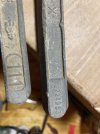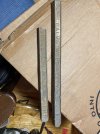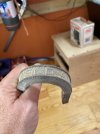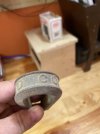You are using an out of date browser. It may not display this or other websites correctly.
You should upgrade or use an alternative browser.
You should upgrade or use an alternative browser.
Any guesses?
- Thread starter Sloughfoot
- Start date
Dusty Bannister
Well-Known Member
Try this for the National Lead product.
JonB
Halcyon member
I've scrounged lots of unknown lead and/or lead alloy. The bars can be anything a supplier would offer a buyer, and those markings don't tell "me" anything. So, I can only go by "looks", which is surely subjective. Judging only by appearance, I'd say they are both pure Lead. They both have that blue/grey age tarnish which is typical of pure lead, anything with tin, would not have age tarnish like that. They both have some handling dents, indicating it's gonna be something soft.
That's my 2¢
That's my 2¢
RicinYakima
High Steppes of Eastern Washington
Auto body solder, usually 60/40 or 50/50 lead/tin.
Sloughfoot
Member
Sloughfoot
Member
And this one took less oomph50-50 probably.
bend it.
if you gotta oomph the hell out of it, and it cracks its got tin.
Attachments
RicinYakima
High Steppes of Eastern Washington
There was a Fisher Body plant near where I went to high school. In the '50's and early '60's car body seams were filled with solder before priming. Those guys were top paid workers who could make a smooth fill in just seconds.
Dusty Bannister
Well-Known Member
In the reference I posted earlier, page D-3, Dutch Boy 111 is 50/50 solder. If you have a hardness tester, see if the galv weld alloy is the same hardness.
fiver
Well-Known Member
i've never seen one crack up like that,,, wow.
gotta remember that lead tin alloys will age soften over time, it comes back when you re-melt it though.
body lead come in all sorts of tin amounts.
the less tin the more flat the panel it was designed to be used on.
anyway.
it come from 5% up to 50%, and in shapes from little round 1/4" ropes, to star shapes, and even little flat ribbons.
i have about 15 lbs. of the various body lead shapes kicking around here i got from the wife's grandpa's garage.
gotta remember that lead tin alloys will age soften over time, it comes back when you re-melt it though.
body lead come in all sorts of tin amounts.
the less tin the more flat the panel it was designed to be used on.
anyway.
it come from 5% up to 50%, and in shapes from little round 1/4" ropes, to star shapes, and even little flat ribbons.
i have about 15 lbs. of the various body lead shapes kicking around here i got from the wife's grandpa's garage.
358156 hp
At large, whereabouts unknown.
One thing... "Galvanized" usually means there's zinc in it. This is odd in this instance because you must remove all traces of zinc on any metal you're welding, and it's identified as a galv. weld alloy, whatever that may be. Galvanized? Galvanizing? I assume.

Brad should be by soon, since I used the words "identified", and "assume" for bait.
Brad should be by soon, since I used the words "identified", and "assume" for bait.
Last edited:
Mitty38
Well-Known Member
No guess here.The Galvaweld is 30,%tin/70%lead. Used for filling seams. It sticks to Galvanized metal really well with the right flux. They also sold zink products, like the old Zink Chromate.
The 111 is 50%/50% used for lead spooning. (finish and dent work)
That way if you are real good at playing with the flame, Spoon and cooling rag. You can finish over, or around the 30/70 without disturbing the seam fill.
111 was usually about 25% more expensive so often.
The galva weld (30/70) was also used to repair dents. But when it came to time and material waist. I don't think a fellow saved too much by not just using the 111.
I can still buy the Galvaweld in my state.
The 111 is 50%/50% used for lead spooning. (finish and dent work)
That way if you are real good at playing with the flame, Spoon and cooling rag. You can finish over, or around the 30/70 without disturbing the seam fill.
111 was usually about 25% more expensive so often.
The galva weld (30/70) was also used to repair dents. But when it came to time and material waist. I don't think a fellow saved too much by not just using the 111.
I can still buy the Galvaweld in my state.
Last edited:
Mitty38
Well-Known Member
Bit of trivia. There should be a dutch boy embellishment on the111 bar. If it was not a knock off brand.
It was originally sold by the dutch boy paint jobber. They used to sell lead and zink based body supplies and the old lead pigment Enamel.
Before Sherwin Williams bought them out. In the 80's.
There was a lot of back stock so original Dutch Boy 111 was available for some years after.
It was originally sold by the dutch boy paint jobber. They used to sell lead and zink based body supplies and the old lead pigment Enamel.
Before Sherwin Williams bought them out. In the 80's.
There was a lot of back stock so original Dutch Boy 111 was available for some years after.
Last edited:
Sloughfoot
Member
Thanks man for helping out. I might cut it up in small chunks and use it for tin additiveBit of trivia. There should be a dutch boy embellishment on the111 bar. If it was not a knock off brand.
It was originally sold by the dutch boy paint jobber. They used to sell lead and zink based body supplies and the old lead pigment Enamel.
Before Sherwin Williams bought them out. In the 80's.
There was a lot of back stock so original Dutch Boy 111 was available for some years after.
Sloughfoot
Member
Thank you everyone who replied




